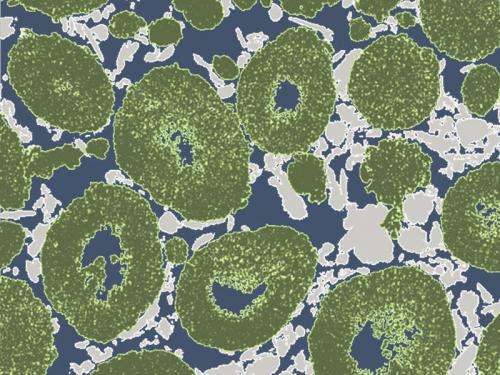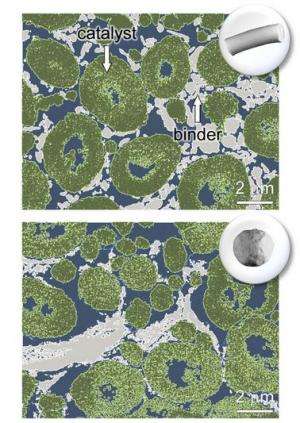Engineers study the inner world of complex catalysts

(Phys.org)—Using state-of-the-art visualization techniques, chemical engineers at ETH Zurich explore the complex inner life of porous catalysts. Their work will aid in the development of rational catalyst design, allowing promising laboratory leads to find their way into large-scale industrial production.
Zeolites are an indispensable part of our everyday lives. This porous material is, for example, applied as a water softener in washing detergents, used in the purification of water, and for the production of pure oxygen. Zeolites are furthermore utilized for cat litter, and as catalysts in the chemical industry, especially in the refining of oil and gas. The latter consists of a hydrocarbon mixture that is converted into high-value end products such as gasoline, diesel, or fuel by the addition of a zeolite to a chemical reaction.
All over the world, chemists are researching new routes to modify the structure of zeolites to improve their performance in chemical processes. For this kind of research, it is crucial to know the interior of catalysts in detail. Scientists at ETH Zurich have for the first time investigated the complex organization of zeolite catalysts using a whole arsenal of different state-of-the-art visualization techniques. They obtained very detailed images of the interior structure of a newly developed zeolite catalyst, applied in the chemical conversion of xylene – a precursor in the production of PET bottles.
Complex porous materials
This novel, integrated visualization approach will be especially beneficial in the process of scale-up, that is, the step from the laboratory to the plant scale in the catalyst development. "At the moment, only a marginal fraction of potential zeolite leads make it to industrial realization", states Javier Pérez-Ramírez, Professor at the Institute of Chemical and Bioengineering, who leads the project. Most academic research institutions, however, work only with small quantities of zeolite powders, and do not consider the influence of the scale-up. The group of Pérez-Ramírez is one of the few worldwide that studies zeolite catalysts in their technical form. In industry, often geometric bodies, such as granules and extrudates, that are made of zeolite powders and various binder materials are employed. "These zeolite bodies belong to the most complexly organized porous materials known", says Pérez-Ramírez.

Optimized zeolite catalyst bodies contain hierarchically structured pores of varying sizes. The smallest pores are in the nanometer region. These "micropores" are inherent to the lattice structure of material, synthesised from aluminium- and silicon-containing precursors. Hierarchical zeolites are moreover chemically modified using alkaline solutions to leach additional bigger pores. These "mesopores" transform the zeolite particles into a kind of sponge that facilitates the movement of reactant molecules to the micropores, where the chemical reaction takes place. Finally, even bigger pores – so-called macropores – are created when the zeolite powder is shaped into technical bodies with a binder.
State-of-the-art techniques from medicine and biology
Pérez-Ramírez and his group utilised for their investigations nearly a dozen different visualization techniques, many more commonly known from their use in medicinal and biological research. These include X-ray, optical, electron microscopic and tomographic methods. This study could only be realized owing to the fruitful cooperation with a partner of the chemical industry, the Electron Microscopy Center of ETH Zurich, and the Paul Scherrer Institute.
For the majority of techniques applied, dedicated specimen preparation provided the greatest challenge, stresses Pérez-Ramírez. That meant days of precision-cutting, such that the smallest usable samples from the catalyst body could be obtained without destroying the internal structure of the material.
Novel catalysts for the petrochemical industry
"For the first time, our images allow us to gain an insight into the distribution of components inside the technical catalyst", states Pérez-Ramírez. The information of how uniformly the zeolite and binder particles are dispersed is important to determine the performance of a catalyst. The chemical engineer argues that, in the process of catalyst design, more attention should be attributed to the stage of scale-up, and that the fact that zeolite catalysts are extremely complex materials should be more carefully considered. He is convinced that "our visualization work is a corner stone in this matter". One potential application is the development of novel catalysts for the petrochemical industry. A research project, in which Pérez-Ramírez is currently involved, is the development of catalysts for the production of olefins, a class of common primary chemicals, a from methanol, a major biogas component becoming more and more important.
More information: Mitchell S, Michels NL, Kunze K, Pérez-Ramírez J: Visualisation of hierarchically structured zeolite bodies from macro to nano length scales. Nature Chemistry, 2012, online advance publication, DOI: 10.1038/nchem.1403
Journal information: Nature Chemistry
Provided by ETH Zurich

















